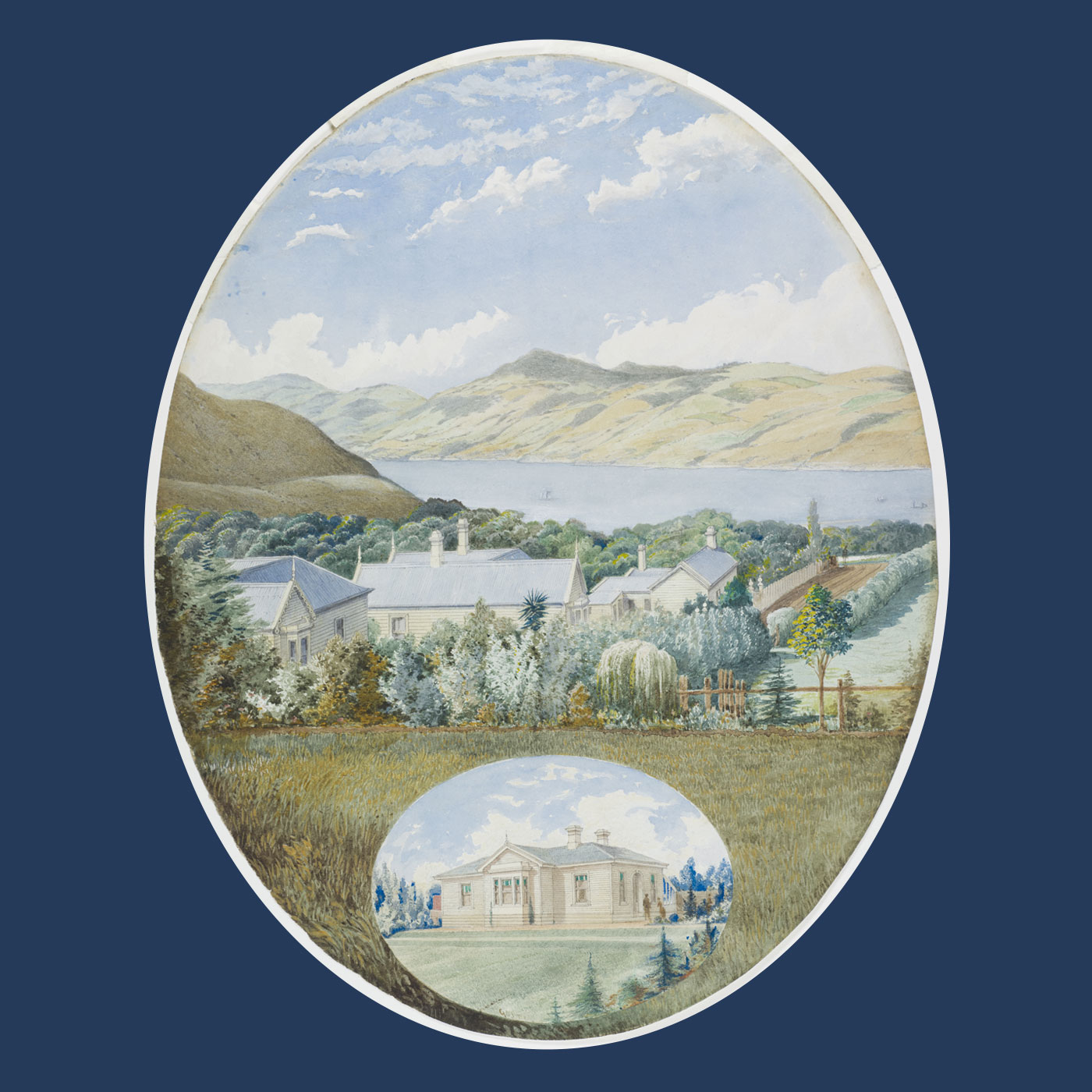Painterly puzzle
A new acquisition by the Hocken Collections is something of a mystery: where is this homestead, why has the artist focused on it in this way, who lived there, was it ever built?
Last year the Hocken Collections purchased this delicate and unusual watercolour by 19th century artist George O'Brien (1821-1888). The Hocken has other examples of watercolours and drawings by O'Brien, but none like this. Nor have O'Brien scholars in New Zealand seen another like it.
Titled Dunedin Homestead and dated circa 1880, it depicts several houses set in a landscape view over the Dunedin Harbour across to the Otago Peninsula. Finely drawn and predominantly painted in subtle shades of blue and green, the scope of the view and attention to detail, combined with a luminous air are characteristic of O'Brien's style. It is as if we are looking through a timeless portal at Ōtepoti Dunedin on a great day – 25 degrees, a light breeze and clear skies.
However, while this painting is an exceptional work of art, it is unique among O'Brien's oeuvre because of the format used, whereby a small horizontal oval is painted into the foreground of the larger oval. This elegant compositional device enables the artist to depict a different view of one of the houses probably included in the larger view.
Born in County Clare, Ireland, and employed as an engineer and architectural draughtsman in Melbourne, O'Brien had secured his reputation as an accomplished water-colourist before arriving in Dunedin in 1863. Here he worked initially as a perspectivist for leading New Zealand architects including William Mason, Robert Lawson, Thomas Forrester and William Clayton. He went on to become a founding member of the Otago Art Society in 1876 and dominated the society's first exhibition with 28 works. While his topographical paintings and skills as a draughtsman were much admired, his work wasn't considered “art” by some aesthetes and art critics of the day. Instead, the moody and atmospheric romantic painting style of O'Brien's contemporary John Gully (1819-1888) was considered the high point of artistic achievement.
It wasn't until the 1980s that O'Brien officially received his due when local art historians Dr Roger Collins and Peter Entwisle presented the exhibition and associated publication Pavilioned in Splendour at the Dunedin Public Art Gallery. Their research cemented O'Brien's reputation in New Zealand's art history as both an artist and draughtsman of exceptional merit, whose work to the modern eye is remarkable for its aesthetic qualities.
The Hocken Pictorial Collection contains more than 40 George O'Brien paintings, some of them originating from Dr Hocken, whose interest in history rather than aesthetics, led him to acquire O'Brien, but not Gully! Subjects represented among the Hocken's O'Briens include architectural paintings of domestic houses and dwellings, and of institutions such as Otago Boys' High School, Knox Church and Seacliff Hospital, landscapes of the Otago Harbour and the Otago Peninsula, views of Dunedin and its hinterland, and studies of natural features such as waterfalls, lakes and mountains. There are also working drawings and several finely executed, highly accomplished pencil drawings, some in the oval format. One exceptional watercolour is Perspective Drawing of House Designed by R. A. Lawson, 1879: Dunedin Homestead shares similarities with this work, particularly in the painterly treatment of the foliage.
So where is this Dunedin Homestead? Was the house depicted in the small oval, with its terraced manicured lawn and the group of houses cosily nestled among greenery, ever built? And, if so, for whom and where? Because O'Brien often worked from architects' drawings and elevations rather than directly from finished buildings, he sometimes set buildings in attractive, recognisable locations; and the details of these buildings may not be shown as they eventually appeared if constructed.
Dunedin Homestead is, therefore, quite a tease. The mid-ground border of dense trees suggests a location around the Town Belt, and the view of the Peninsula landscape in the distance – which is recognisable today – make it tempting to believe this painting depicts an actual domestic property, rather than just an architect's drawing set into a real, but fictitious location.
If you know, or think you know this house, live in it or have worked out what's going on in this picture, please let us know and help us solve the mystery of the Hocken's Dunedin Homestead. If you'd like to see the painting, you're welcome to come and take look at it in Hocken Pictures: please telephone 479 8868 or email hocken@otago.ac.nz
Robyn Notman,
Head Curator, Pictorial Collections,
Hocken Collections, Uare Taoka o Hākena.
George O'Brien (1821-1888), Dunedin Homestead, c. 1880, watercolour on paper, 370 x 290mm (oval), Acc: V2019.10.2, Hocken Collections, Uare Taoka o Hākena, University of Otago.

